Themed collection Editor’s Collection: Imperfect nanocrystals for Perfect Catalysis

Vacancy-engineered catalysts for water electrolysis
Vacancy-engineered electrocatalysts showing various effects on improving performances toward water electrolysis.

CrystEngComm, 2020,22, 1500-1513
https://doi.org/10.1039/C9CE01883B
Recent advances in transition metal based compound catalysts for water splitting from the perspective of crystal engineering
A review of the recent progress on the transition metal based catalysts for water splitting with emphasis on crystal engineering.
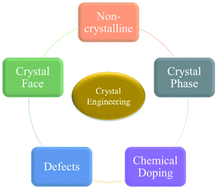
CrystEngComm, 2020,22, 1531-1540
https://doi.org/10.1039/C9CE01533G
Flower-like tungsten-doped Fe–Co phosphides as efficient electrocatalysts for the hydrogen evolution reaction
In this article, we introduce W into Fe–Co phosphides to optimize the hydrogen adsorption energy thereby accelerating the kinetics of the HER.
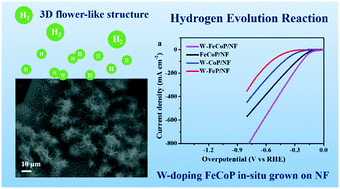
CrystEngComm, 2021,23, 4724-4731
https://doi.org/10.1039/D1CE00426C
Facile formation of Fe-doped NiCoP hollow nanocages as bifunctional electrocatalysts for overall water splitting
Rational design of electrocatalysts with unique morphological structures and chemical compositions is crucial for electrochemical performance and energy storage capacity.
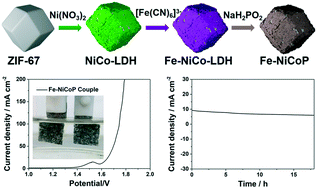
CrystEngComm, 2021,23, 3861-3869
https://doi.org/10.1039/D1CE00415H
Surface oxygen vacancies of TiO2 nanorods by electron beam irradiation for efficient photoelectrochemical water splitting
TiO2 nanorods with oxygen vacancies are produced via a facial, controllable and scalable high energy electron beam irradiation treatment, resulting in a remarkable enhancement of photocurrent density of about 85.4% at 1.23 VRHE.

CrystEngComm, 2021,23, 2952-2960
https://doi.org/10.1039/D1CE00205H
Comparison of the effects of cation and phosphorus doping in cobalt-based spinel oxides towards the oxygen evolution reaction
Phosphorus incorporation further boosted the OER activity of cation-doped Co-based spinel oxides via remarkably tuning the oxygen vacancies, crystallinity and electrochemically active surface area on the surface.
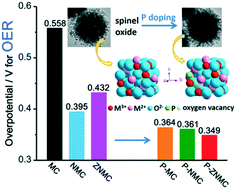
CrystEngComm, 2021,23, 1849-1858
https://doi.org/10.1039/D0CE01771J
Enhanced photoluminescence and photocatalytic performance of a TiO2–ZnWO4 nanocomposite induced by oxygen vacancies
We reported the enhanced photoluminescence and photocatalytic performance of a TiO2–ZnWO4 nanocomposite and discussed the mechanism behind the superior behavior in this study.

CrystEngComm, 2021,23, 1336-1344
https://doi.org/10.1039/D0CE01500H
Few-layered CuInP2S6 nanosheet with sulfur vacancy boosting photocatalytic hydrogen evolution
Uniform few-layered CuInP2S6 nanosheets and microsheets were initially synthesized and utilized as photocatalysts towards photocatalytic hydrogen generation.
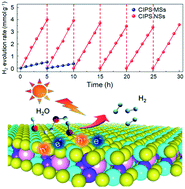
CrystEngComm, 2021,23, 591-598
https://doi.org/10.1039/D0CE01487G
Optimization of the overall water-splitting performance of N, S co-doped carbon-supported NiCoMnSx−10 at high current densities by the introduction of sulfur defects and oxygen vacancies
This work reports the synthesis of N and S co-doped carbon-supported NiCoMnSx−10 electrocatalyst and its application in electrocatalytic overall water splitting.
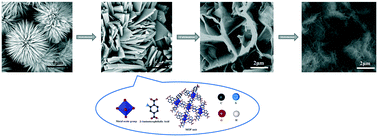
CrystEngComm, 2020,22, 6239-6248
https://doi.org/10.1039/D0CE01075H
Tuning of the morphological and electronic properties of In2S3 nanosheets by cerium ion intercalation for optimizing photocatalytic activity
The influence of cerium on the evolution of the morphological and optoelectronic properties of In2S3 nanostructures has been experimentally and theoretically investigated.
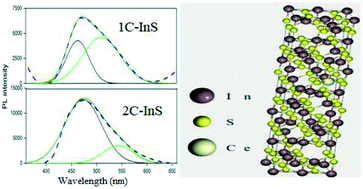
CrystEngComm, 2020,22, 4758-4767
https://doi.org/10.1039/D0CE00674B
Engineering CuOx–ZrO2–CeO2 nanocatalysts with abundant surface Cu species and oxygen vacancies toward high catalytic performance in CO oxidation and 4-nitrophenol reduction
CuOx–ZrO2–CeO2 nanocrystalline catalysts were designed and synthesized by a solvent-free synthetic strategy, and exhibited excellent catalytic performance owing to the increased oxygen vacancies and better dispersed active metal species.
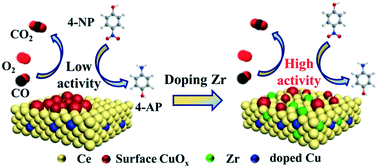
CrystEngComm, 2020,22, 4005-4013
https://doi.org/10.1039/D0CE00588F
Defective crystal plane-oriented induced lattice polarization for the photocatalytic enhancement of ZnO
The mechanism of the photocatalytic reaction of defective ZnO systems was determined.
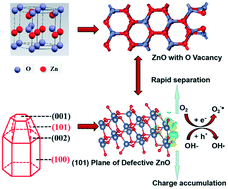
CrystEngComm, 2020,22, 2709-2717
https://doi.org/10.1039/C9CE01966A
Cu-Deficient plasmonic Cu2−xS nanocrystals induced tunable photocatalytic activities
Cu-Deficient plasmonic Cu2−xS nanocrystals with tunable photocatalytic activities were synthesized and investigated.
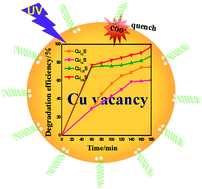
CrystEngComm, 2020,22, 678-685
https://doi.org/10.1039/C9CE01501A
About this collection
Vacancies, dopants, and defects are synonymous with imperfect atom ordering in crystalline materials. While dopants have been extensively exploited to fine-tune the material properties of semiconductors, the relevance of atom vacancies and defects to the activity and stability of nanoparticle-based catalysts has been recognized only recently. Intentional disturbance in the atom ordering in nanocatalysts has led to the development of nanocatalysts with exceptional catalytic activity and stability. However, the ability for controlled introduction of defects and vacancies to the desired locations and amounts, while maintaining the nanoparticle material phase is only at the fledgling stage, not to mention our understanding of the true origin of the superb catalytic performance of them. This selection of articles, handpicked by Associate Editor Professor Kwangyeol Lee, Korea University, would point to the importance of imperfect nanocrystals to the development of perfect nanocatalysts.